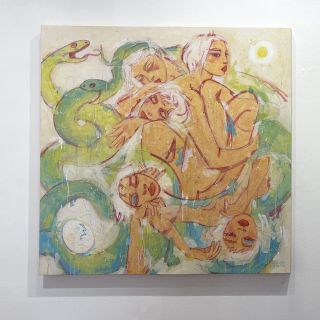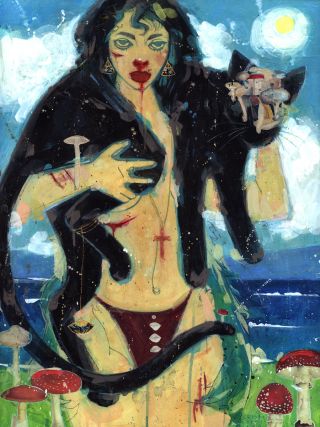OCD
A Painter Sheds New Light on OCD
An interview with artist and OCD advocate Cristi López.
Posted June 6, 2024 Reviewed by Margaret Foley
Key points
- The artistic process highlights unexpected insights about OCD.
- The act of creating can help artists embrace the dynamic nature of the mind.
- Exploring OCD from a place of curiosity, not fear, can lead to a more subtle understanding of the disorder.

There's something magical in artist Cristi López's work that stands on its own. And yet, if you look closer, you'll find unexpected connections to her OCD advocacy that will delight and surprise you too.
I had a chance to sit down with López to chat about these fascinating connections and their implications for a new way of viewing OCD.
Michael Alcee: How did you come to the show's title, Anima?
Cristi López: Initially, I was intrigued by the closeness anima had to the word animal. Human/animal interaction is the most readily apparent motif of the show, and my work has long explored themes of femininity and psychology, so even a surface-level understanding of anima felt relevant. Upon further research, the title became even more fitting. From anima as Jung's concept of the feminine subconscious to its Latin translation as the "soul or animating principle," I realized that trusting my initial feeling led me to a wealth of inspiration and substance.
Like my relationship to OCD, I've learned to trust that meaning will disclose itself to me in the process. That's really opened things up for me.
MA: Yes, that's a novel take on OCD. It suggests that learning to trust your instincts and emotional associations can sometimes surprise you with unexpected gifts. It goes against the kind of absolute certainty that often dominates obsessional cycles.
Meaning emerges from what isn't at first wholly understood. It reminds me of poet John Keats's concept of negativity capability, the capacity to explore mystery and contradiction with delight rather than fear or concern.
That's almost the opposite of OCD, a way to transform the fear and terror of OCD into the creative obsession that comes with being a close observer of the world.
CL: I think we lose touch with trusting that place of not knowing. Making room for discovery along the way is more "feminine," covert, mysterious, and so important to embrace in the creative process. Embracing that side of myself has also been a vital part of my OCD recovery: learning to see a kind of wisdom and beauty in what at first blush might seem messy, ugly, or problematic.

MA: Yes, I love this idea you're following that has such relevance to OCD treatment. Maybe we can trust the anima and the process more. Let's see what we can learn about the fuller story of your emotional experience by becoming more curious about where things take you.
Currently, many kinds of OCD treatments, especially exposure-response prevention, are singularly focused on the outcome. Habituate to whatever mystifies you rather than engaging a sort of dialogue and conversation with it. Internal family systems is one of the few OCD treatments that begins to come from this place of curiosity.
CL: As a creative with OCD, I've struggled with the feeling that I have to overexplain my art so that my intentions aren't misconstrued and that I've identified every bit of meaning (or else, it's meaningless!). I'm now at a place where the need to know doesn't feel as pressing. I recognize that my mind and the logical and analytical sides of my OCD were demanding control in an area where it was unwarranted.
MA: Yes, the mind needs to be in control, but the muse doesn't. I've always felt that OCD is a great reminder for all of us to make sure that the head and heart are more integrated and respectful of each other. The OCD mind prefers to have clear-cut distinctions and gets afraid when blurriness seems to threaten rather than enhance the picture.
But that's what I love about your work. It showcases that tendency in all of us to dialogue these sides, and most particularly, it shines a light on how OCD can be understood with much more subtlety.

CL: Creating helps me continually embrace the dynamic nature of the mind; it is in a constant state of transformation. Nature itself is in a constant state of change, and we run into significant problems in stubborn attempts to bend it to our will. Animals, an integral part of the natural world, feel like an honest way of portraying visceral aspects of our internal landscape. Painting animals interacting with humans is an opportunity to engage in fuller and freer conversation with all these covert facets of ourselves.
MA: That's a lovely way of putting it. Your work does something that is essential in art and life. Moving back and forth between the literal and the metaphorical enables us to not only be more creative it allows us to be most fully ourselves. And whether we are talking about OCD or any other psychological disorder, it is that integration that allows us to connect back to anima, the animating principle within all of us.




